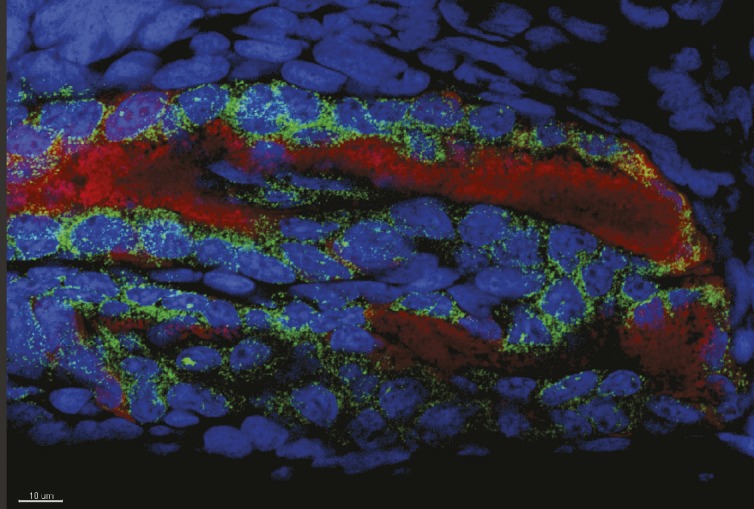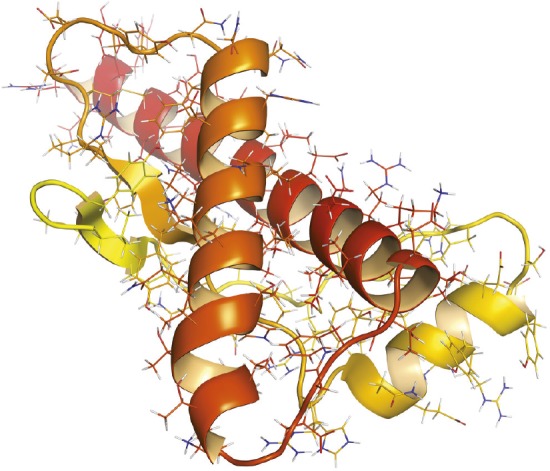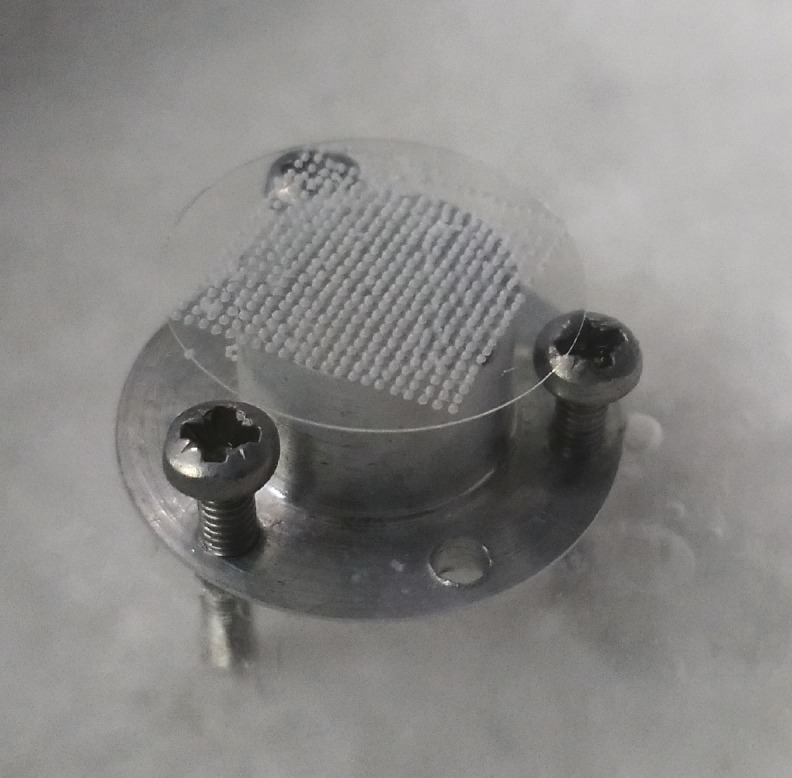Symbiosis and gene expression in luminescent squid

Luminous symbionts (red) induce edema-associated gene expression (green) in host epithelia (nuclei, blue).
Animal microbiomes can affect tissues and organs anatomically distant from those with which they directly associate. However, the mechanisms underlying these effects remain unknown. Using the symbiosis between the Hawaiian bobtail squid, Euprymna scolopes, and the luminous bacterial symbiont, Vibrio fischeri, Silvia Moriano-Gutierrez et al. (pp. 7990–7999) compared gene expression in the light organ, where the bacteria reside, as well as the eye and gill, in the presence and absence of symbionts, in juvenile and adult animals and at different stages of the day/night cycle. Gene expression levels in both juveniles and adults differed in all three organs between symbiont-free and symbiont-colonized animals, and each organ had a unique set of differentially expressed genes. For certain genes in the eye and gill, the effect of symbiosis on expression varied with the time of day, with maximal effect in the early evening when the host is active. When colonized by a mutant symbiont unable to produce light, fewer genes in the light organ responded, and all of the typically responsive genes in the eye did not respond to the mutant symbionts. The results suggest that colonization of the squid light organ by V. fischeri causes system-wide changes in gene expression, some of which are driven by bioluminescence. — B.D.
CAR T cell therapy and tumor microenvironment
Chimeric antigen receptor (CAR) T cell therapy, an emerging form of cancer immunotherapy, reprograms immune system cells to target specific cancer-associated antigens. Although CAR T cell therapy has proven effective against hematological cancers in clinical trials, solid tumors represent a challenge because they develop in immunosuppressive environments and rarely express tumor-specific antigens. Yushu Joy Xie et al. (pp. 7624–7631) developed a strategy for CAR T cells that targets the tumor microenvironment instead of the tumor. Using variable regions of heavy-chain–only antibodies as recognition domains, the authors devised CAR T cells keyed to targets in the microenvironment that tumors need to thrive, such as the checkpoint inhibitor PD-L1, a protein expressed by tumors that shields them from the immune system, and the EIIIB+ fibronectin splice variant, a hallmark feature in tumor angiogenesis and vasculature. The authors also conducted trials demonstrating that treatment with CAR T cells that target PD-L1 and EIIIB+ reduces tumor growth and improves survival rates in immunocompetent mice. The findings offer a proof-of-concept for using CAR T cells against a range of solid tumor types in a fully immunocompetent system, according to the authors. — T.J.
Evolutionary history of perching birds

Cape sugarbird (Promerops afer) perched atop a sugarbush.
Passerines, or perching birds, comprise more than 6,000 extant species and represent 60% of bird diversity. How Earth’s history influenced the evolution of passerine diversity remains poorly understood. Carl Oliveros et al. (pp. 7916–7925) constructed a comprehensive passerine evolutionary tree based on DNA sequence data from representatives of all 137 passerine families, including the extinct Hawaiian honeyeaters. The resulting tree clarified the relationships among the major passerine groups. After calibrating the timing of divergence between the various groups using 13 fossils of passerines and closely related birds, the authors estimated that passerines began to diverge in the Middle Eocene, approximately 47 million years ago. Models of biogeographic dispersal suggested that passerines originated in the Australo-Pacific region. The reconstructed evolutionary history reflects the influence of major climatic events, such as a period of extinction followed by rapid diversification during the Oligocene glaciation. The rate of diversification fluctuated throughout the Cenozoic Era but did not exhibit a strong correlation with global temperatures, in contrast to observations for modern birds. Nor were shifts in the diversification rate associated with the colonization of new continents. The results reconcile passerine evolutionary history with the fossil and geological records and suggest that complex mechanisms drove diversification, according to the authors. — B.D.
How neighborhoods predict social mobility
Growing up in disadvantaged neighborhoods affects social mobility later in life, but the specific factors that shape social mobility remain largely unexplored. Using a sample of around 230,000 individuals, Robert Manduca and Robert Sampson (pp. 7772–7777) examined neighborhood environment data provided by the Project on Human Development in Chicago Neighborhoods, as well as the census, health, and income tax records of parents and children from Chicago. The authors found that exposure to environments that are harmful to child development, namely environments with high levels of lead, incarceration, and violence, predicts adult income relative to that of parents as well as other aspects of well-being, independent of neighborhood poverty. The greater the extent to which poor black male children were exposed to harsh environments, the higher their chances of being incarcerated in adulthood and the lower their adult incomes. Similar adulthood income patterns emerged for poor white children. Moreover, increased exposure to harsh childhood environments predicted increased rates of teen pregnancy among both poor black and white females. Chicago’s racial segregation disproportionately exposes black residents to neighborhoods that are harmful to mental and physical health. Reforming the criminal justice system and maintaining neighborhood health by reducing violence and toxic pollutants may help increase social mobility, according to the authors. — M.S.
Potential biomarker for prion disease drugs

Schematic of prion protein. Image courtesy of iStock/Molekuul.
Improper folding of prion protein (PrP) causes prion diseases such as Creutzfeldt–Jakob disease and fatal familial insomnia. Experimental treatments for prion diseases attempt to lower brain PrP levels, but the success of such treatments depends on biomarkers that can reliably detect and quantify PrP in human cerebrospinal fluid (CSF). To analyze human PrP’s potential as a biomarker for monitoring treatment response, Sonia Vallabh et al. (pp. 7793–7798) tested the performance of the commercial BetaPrion ELISA assay on 225 samples from patients with symptomatic and presymptomatic prion disease as well as controls. The test revealed high variability in PrP levels within and across cohorts, likely due to differences arising from adherence of PrP to plastics used in sample preparation. Adding a common detergent to the CSF samples increased PrP solubility and reduced PrP loss to plastic. Comparison of PrP levels across brain samples, CSF samples, and blood fractions indicated that the test largely measures central nervous system-derived PrP rather than blood-derived PrP—a feature crucial to PrP’s validity as a clinical biomarker for prion diseases. Importantly, CSF PrP levels exhibited low variability—around 13%—when measured at different times in a subset of nine individuals under highly controlled sample processing conditions. According to the authors, PrP can be reliably and reproducibly measured in human CSF and may represent a potential biomarker for drug development, particularly among presymptomatic individuals with high-risk mutations for prion diseases. — P.N.
Inkjet printing aids cell cryopreservation

Inkjet-printed droplet array on a thin glass.
Cryopreservation allows living cells to be stored over the long term without contamination, degradation, or genetic drift. Current cryopreservation methods require at least one cryoprotective agent (CPA) to ensure that water inside and outside cells vitrifies instead of forming ice crystals, which can damage cells. Noting that CPAs are cytotoxic and carry potential side effects, Yoshitake Akiyama et al. (pp. 7738–7743) developed a CPA-free method of cryopreservation that achieves ultrarapid cooling using inkjet cell printing. Dubbed superflash freezing (SFF), the technique prints small cell-containing droplets on glass substrates and freezes the droplets indirectly by cooling the substrate with liquid nitrogen. The authors used computer simulations to confirm that the technique’s cooling rate is optimal and conducted experiments with mouse cell lines and rat primary mesenchymal stem cells. The experiments revealed that SFF nearly vitrifies mammalian cells in a manner that compares favorably to conventional CPA-assisted cryopreservation. Although further research is required to ensure the long-term integrity of cells frozen using SFF, the study demonstrates that SFF is a viable strategy for CPA-free cryopreservation, according to the authors. — T.J.


